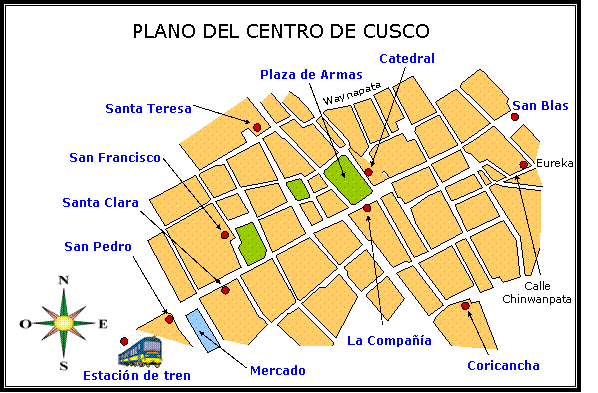
The City Tour is a good option to get familiar with this wonderful city and at the same time you slowly can adjust to the high altitude of Cusco through this relaxing bus ride. We will start at the Plaza de Armas (main square), where you see the famous Cathedral and then we stop to see Qoricancha, the most important temple of the Inca Empire and rebuild by the Spaniards into a monestary, named “Santo Domingo”. Then we pass by “Sacsayhuaman”, the ruins of a huge fortress, located on a steep hill overlooking the city. The tour shows the incredible mix of Inca and Spanish-style buildings, creating a sense of mystery. All these attractions are important in a time of a constant cultural development in architecture, religion and politics. This tour is a “must” when visiting the archaeological Capital of South America”.


Around 2 p.m. we´ll start the guided bus tour through Cusco at the Main Square. Here you see the Cathedral, built in 1559, on the foundations of the Inca Temple Kiswarcancha. Kiswarcancha was the temple of Viracocha, the Inca Ruler of Cusco. This location was chosen by the Spaniards to demonstrate their religious catholic power and to remove the inca religion from Cusco. The Cathedral is home of more than 300 paintings and other artefacts, mainly originated from the “Escuela Cuzquena (Cusco School of arts)”.
Then we drive to the Santo Domingo Convent, built on “Qoricancha, the temple of the sun”. While the Spanish convent was several times destroyed through earth quakes, the leftovers of the former inca temple stayed intact. When the Spanish conquistadors had arrived, the walls of Qoricancha were covered with sheets of gold and the courtyard was filled with golden statues.
Next stop will be at “Sacsayhuaman”, a huge majestic fortress on a hillside above the city, build out of big stones without the use of mortar. Some stones, transported from remote quarries, weigh more than 120 tons. At Sacsayhuaman, thousands of men and women, dressed in colourful inca costumes celebrate “Inti Raymi”, the annual Inca Festival for the Winter Solistice and New Year on June 24th.
Just 200 m away is our next destination: Q’enqo (labyrinth), religious center, dedicated to the worship of the Earth and, according to some theories, to funeral rituals, like sacrifices and mummifications.
We finalize our bus tour by visiting Puca Pucara and Tambomachay. Puca Pucara means red fortress in quechua and is a great example of military architecture, that also functioned as an administrative center. Tambomachay (temple of the water) consists of aqueducts, canals and waterfalls, running through terraced rocks and was most likely used as a spa resort for the Inca elite.
In the late afternoon we return to the Cusco Main Square..